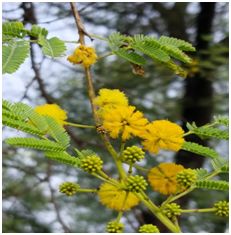
Botanical Name – Acacia nilotica (L.)Delile
Common Name – Babul
Classification –
Kingdom – plantae
Division – Magnoliophyta
Class – Magnoliopsida
Order – Fabales
Family – Fabaceae
Genus – Acacia
Species – nilotica
Characterstics Of Family Fabaceae –
This family also called bean and legume .our species in the fabaceae include trees, herbs, shrubs and lianas. The leaves are alternate and in most species are divided into leaflets. Flower may be borne singly or may be grouped into various arrays. Flower are actinomorphic and zygomorphic . the sepal form a tube with lobes that are often of different lengths. The petals are often arranged such that a larger . There are usually 10 stamens and 1 ovary which has a single style and stigma . the fruit ususlly a legume , rarely the fruit is a schizocarp.
Habitat - Almost all tropical and sub tropical .
World Distribution – Africa, Asia , Australia .
Distribution – Himachal Pradesh , Bihar, Gujrat, Haryana, Madhya Pardesh, Punjab, Rajasthan .
Status – Least concern
Plant Distribution -
A medium-sized almost evergreen tree, straight or crooked, tree with dark-blackish-brown, irregularly, longitudinally fissured bark. Stem Woody but upper portion herbaceous,aerial, erect, branched, solid, dark brown bark; a gum is secreted from the bark, gum Arabica.
Leaves Ramal and cauline, alternate, stipulate, stipules long straight, white thorns, petiolate, compound, bipinnate and paripinnate, pinnae 5-7 pairs, pinnules 10-20 pairs, sessile or subsessile, minute, ovate or oblong, entire, unicostate reticulate. Inflorescence Axillary cymose head.
Flowers tiny, clustered together in bright-yellow, round heads. Fruits A lomentum, pods linear-oblong, glaucous-green, jointed, joints nearly orbicular, compressed, minutely hairy. Seeds : Many, large, non-endospermic, brownish-black, oblong, compressed, smooth, glabrous.
Uses
The roots are used against cancers and/or tumors (of ear, eye, or testicles),
tuberculosis and indurations of liver and spleen.
Chemoprventive, anitmutagenic, anti bacterial, anticancer, astringent, anti microbial activity Tender leaves are used to treat diarrhea, Aphrodisiac, dressing of ulcers,anti-inflammatory and Alzheimer’s diseases.
Anti hypertensive and antispasmodic, anti-diarrhoerial, astringent,anti-fertility and against HIV-1 PR, Inhibited HIV-1 induced cythopathogenicity, antiplatelet aggregatory activity and anti oxidant.
Astringent, emollient, liver tonic, antipyretic and antiasthmatic